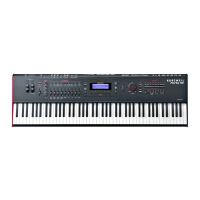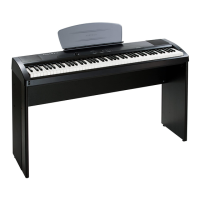The Effects Chain Editor
Effects Parameters
8-22
Stereo Simulation
e Mono to Stereo eect converts a monaural input to simulated stereo output.
In Select selects the input signal to be “stereo-ized.” It can be Left, Right, or both: (L+R)/2.
CenterGain is the level of the summed left and right channels. Range is O/-79.0 to 24.0
dB.
Di Gain is the level of the dierence signal produced, which is the spatial component of
the stereo signal. Range is O/-79.0 to 24.0 dB.
DiBassG controls the gain of a bass-shelf lter on the dierence signal. By boosting the
low frequency components of the dierence signal, you can increase the sense of acoustic
envelopment. Range is -79.0 to 24.0 dB.
DiBassF is the transition frequency for the bass-shelf frequency. Range is 16 to 25088 Hz.
e processed signal is split into three frequency bands—Lo, Mid, and High—each of which
can be delayed and panned separately.
Crossover1 and 2 are the two Crossover frequencies at which the band-split lters split the
signal into three bands. e two parameters are interchangeable: either may have a higher
frequency than the other. Range is 16 to 25088 Hz.
Pan [High/Mid/Low] sets the pan position for each band. Range is -100% (fully left) to
100% (fully right.)
Delay [High/Mid/Low] sets the delay for each band. Range is 0 to 1000 ms.
Stereo Image
is eect provides enhancement for a stereo signal. It also features a stereo correlation meter.
It uses some parameters from Mono to Stereo and some from Stereo Analyze (following).

